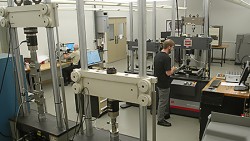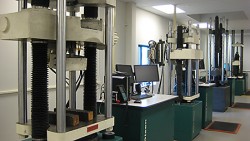Material Testing Lab Precision: Unmatched Precision for Rigorous Material Evaluation
Wiki Article
Advancements in Product Screening Techniques: Insights From a Leading Product Screening Lab
You'll find just how non-destructive testing has actually evolved, check out arising technologies in product evaluation, and learn concerning unique methods to reviewing material buildings. By the end of this short article, you'll have a far better understanding of the cutting-edge methods being made use of in product testing labs, equipping you with the expertise to make informed decisions regarding the products you function with.Developments in Non-Destructive Examining
In this short article, we will certainly explore the most recent innovations in non-destructive testing methods that have actually been pioneered by our leading material screening research laboratory. Non-destructive testing (NDT) plays a critical role in making sure the honesty and quality of materials without triggering any kind of damages. With the constant requirement for even more efficient and accurate testing techniques, our research laboratory has actually gone to the center of developing innovative methods.One of the significant innovations in NDT is the usage of advanced imaging technologies. Our laboratory has successfully integrated high-resolution imaging techniques such as digital radiography and computed tomography into the testing process. These strategies enable precise and detailed inspections of internal frameworks and parts, giving beneficial understandings right into any type of potential defects or weak points.
In addition, our research laboratory has actually also made significant development in the field of ultrasonic screening. By utilizing cutting edge equipment and innovative signal handling formulas, we have actually improved the accuracy and integrity of ultrasonic testing approaches. This enables us to discover and assess even the tiniest flaws or gaps in materials, ensuring their honesty and security.
Additionally, our lab has actually been actively researching and applying sophisticated electromagnetic screening techniques. By using the power of electromagnetic waves, we have the ability to examine and analyze the homes of products without direct call. This non-contact method not just increases the rate and efficiency of screening but additionally reduces the threat of damage to sensitive parts.
Emerging Technologies in Material Evaluation
Exploring emerging technologies in material analysis can offer important insights into the high quality and residential properties of products. Spectroscopic strategies like infrared spectroscopy and Raman spectroscopy are extensively made use of to recognize chemical bonds and useful teams in inorganic and organic materials.Another arising modern technology in product evaluation is X-ray diffraction (XRD) XRD is an effective tool that can identify the crystal structure of a material, providing details concerning its atomic setup and crystalline stages. This method is particularly useful in the research of minerals, metals, and porcelains, in addition to in the identification of unknown materials.

Enhancing Accuracy and Precision in Evaluating
To improve the precision and accuracy in testing products, you can utilize sophisticated methods and approaches. One reliable approach is the usage of automated screening systems. By have a peek at this website following consistent methods and standards, you can minimize irregularity and enhance the accuracy and accuracy of screening across different research laboratories and operators.Novel Strategies to Assessing Product Characteristics
Making use of advanced methods and methodologies, you can enhance the examination of product homes via cutting-edge methods. One such technique is using non-destructive screening methods. By employing techniques like ultrasonic testing, radiography, and thermal imaging, you can examine product buildings without causing any damage. This not only saves time and resources but likewise enables repeated testing on the same sample, enabling a more extensive understanding of the material's behavior.One more novel method is the unification of advanced computer simulations. With computational modeling and simulation, you can precisely forecast product residential or commercial properties and habits under various problems. This allows you to maximize product design and performance, resulting in the advancement of a lot more reliable and sturdy materials.
Additionally, the use of man-made knowledge and artificial intelligence formulas has actually changed product residential or commercial property assessment. These innovations can evaluate large amounts of data and identify patterns that may not appear to human observers. By training formulas on huge datasets, you can develop anticipating designs that accurately estimate material residential or commercial properties based on numerous input criteria.
Furthermore, microstructure analysis techniques, such as electron microscopy and X-ray diffraction, provide beneficial understandings right into the interior structure of products (material testing lab). By taking a blog look at the plan of atoms and crystal problems, you can acquire a much deeper understanding of product residential properties and their connection with performance
Future Fads in Product Testing
By incorporating arising techniques and innovations, you can stay at the leading edge of product testing developments and efficiently assess material residential or commercial properties for future applications. As modern technology proceeds to evolve, the area of material screening is also undertaking significant adjustments. One of the future fads in material screening is making use of innovative computer simulations. These simulations permit researchers to anticipate product habits under various conditions, lowering the need for physical screening and conserving time and resources. In addition, there is a growing concentrate on environmentally friendly and lasting materials. Material screening research laboratories are now checking out means to evaluate the sustainability and recyclability of materials, ensuring that they satisfy the needs of a more eco-conscious society. One more arising trend is the combination of fabricated intelligence (AI) and artificial intelligence into material testing procedures. AI formulas can analyze large quantities of information and recognize patterns that humans may neglect, causing even more accurate and efficient product screening outcomes. In addition, there is a shift towards in situ and real-time material testing. This method enables scientists to keep an eye on product actions under real operating problems, giving beneficial understandings right into the efficiency and durability of materials. As material screening proceeds to evolve, staying upgraded on these future fads will certainly be critical for ensuring the development of reliable and innovative materials for numerous sectors.Final Thought
To conclude, the innovations in material screening methods discussed in this post highlight the constant efforts of leading labs to boost accuracy, accuracy, and efficiency in screening. Non-destructive testing techniques have actually emerged as an useful tool, while unique approaches and emerging modern technologies provide brand-new possibilities for examining product residential properties. material testing lab. As technology remains to progress, we can anticipate additional innovations and future trends in product screening that will certainly drive innovation and enhance our understanding of products
You'll uncover exactly how non-destructive testing has evolved, explore emerging innovations in product evaluation, and learn regarding unique strategies to evaluating material buildings. By the end of this More Help article, you'll have a better understanding of the innovative methods being made use of in product screening research laboratories, empowering you with the knowledge to make informed decisions about the materials you work with.

Report this wiki page